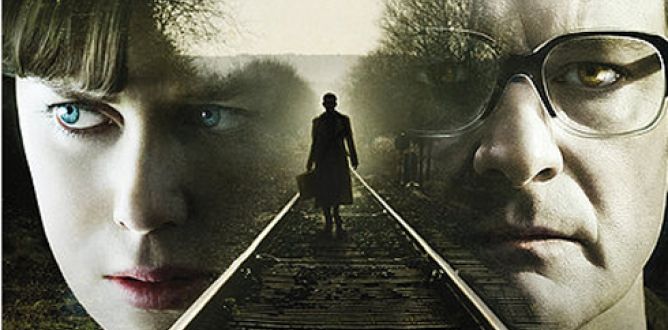The Railway Man Parent Guide
Offering one of the most powerful examples of forgiveness I've ever seen put to film, this movie shows how letting go of grievances, big or small, can heal injuries that can't otherwise be cured.
Parent Movie Review
“Time heals all wounds”, says the old adage. But Eric (Colin Firth) is learning the real truth: Some hurts are too deep to be buried by the ticking of the clock.
It’s the early 1980s and Eric is fixated on the comings and goings of trains. He passes his time riding the rails around the UK. Then one fateful day he sits across from Patti (Nicole Kidman). A short train trip and a few dates later, the pair is married and settling into life together. However Patti quickly discovers her husband’s somewhat peculiar demeanor is due to more than a quirky personality. Looking for answers she turns to one of the few friends Eric has.
Finlay (Stellan Skarsgård) was one of the men her spouse served with during WWII. At first the war buddy is reluctant to discuss what he, Eric and a handful of other men endured while imprisoned in a Japanese POW camp. Yet after Patti’s determined pleading for any information that would help her troubled husband, Finlay finally agrees to talk.
In flashback we learn about the younger Eric (Jeremy Irvine), who was a bright wireless operator and electrical engineer. Captured by the Japanese in Singapore, the twenty-one-year-old soldier was sent to a brutal labor camp where he and thousands of other Allied Forces prisoners became slaves used to build the Burma Railway. Anxious for any sign of rescue, Eric used his skills to cobble together a radio receiver that the men could listen to in the back of a disabled truck. They excitedly shared news of the Allies’ progress with the legions of other POWs, until their enthusiasm was extinguished by their captors’ discovery of the device. Eric, Finlay and a small group of engineers were then taken to another place where they could be tortured and interrogated by a Japanese officer called Nagase (Tanroh Ishida). When Eric bravely took personal responsibility for assembling the radio, the resulting punishment left him mentally scarred.
With this disclosure Patti becomes sure of one thing: Eric needs to face his demon. Working with Finlay, she discovers Nagase (now played by Hiroyuki Sanada) is still alive and operating a museum where the labor camp used to be. Still, Eric is reluctant to make the emotional trip so Finlay sends him a desperate message hoping to convince him to return to the point of his worst nightmares.
The reality of seeing his tormentor again has Eric consumed with the possibility of revenge. Yet when the two enemies actually do come face to face, the reunion doesn’t go exactly as planned.
Based on a book written by the real Eric Lomax, this movie does include some portrayals of beatings, verbal abuse, water-boarding torture and a suicide. While these scenes are disturbing, they are not explicit. I appreciated director Jonathan Teplitzky’s decision to leave the bulk of the violence to our imagination. For instance, when a character is beaten with a club, the camera stays focused on the attacker and only shows the blood-covered victim afterward. Thanks to his restrained visual approach (along with the absence of sexual content and the use of only two very mild profanities) this movie may be appropriate for viewing by some older teens.
And being suitable for a broader audience is a good thing, not just because the film depicts a significant moment in history, but also because The Railway Man has an important message to share—especially for anyone who harbors hurt after suffering an injustice. Offering one of the most powerful examples of forgiveness I’ve ever seen put to film, this movie shows how letting go of grievances, big or small, can heal injuries that can’t otherwise be cured—even with all the time in the world.
Directed by Jonathan Teplitzky. Starring Nicole Kidman, Stellan Skarsgård, Colin Firth, Hiroyuki Sanada, Jeremy Irvine. Running time: 108 minutes. Theatrical release April 25, 2014. Updated July 17, 2017
The Railway Man
Rating & Content Info
Why is The Railway Man rated R? The Railway Man is rated R by the MPAA for disturbing prisoner of war violence.
Violence: This film deals with human abuse and torture. Several scenes depict beating and torture (some with blood effects), including one where a man is subjected to water-boarding. A man hits another man with a large stick (the camera focuses on the abuser and the injured victim is not seen until after the beating is complete). Men are forced into railway cars and taken to POW camps. A character commits suicide by hanging from a rope (this take place on screen). A character looks at sketches of men in POW camps, some of whom are very thin and being subjected to torture. Prisoners of war are forced to work as slaves and build a railway. Dead bodies are shown. After being beaten a man is tied to the back of a motor vehicle and forced to run behind it.
Sexual Content: A married couple undresses to their underwear on their wedding night and embraces on a bed. We see them the next morning in bed with bare shoulders. Later we see the same couple in bed again with bare shoulders.
Language:
A mild profanity is used once and a single term of deity is heard.
Alcohol / Drug Use: None noted.
Page last updated July 17, 2017
The Railway Man Parents' Guide
What do you think Eric was looking for in his first meeting with Nagase? Did he receive it? Is reconciliation a necessary part of the forgiveness process? How can a person take control of his or her own feelings and hurts?
Why is forgiveness so important? Do you think offering forgiveness reveals a weakness within an individual? What do we lose when we forgive? What do we gain? What do we lose if we refuse to forgive?
This movie received an R rating in the US from the MPAA. Yet, when compared to 12 Years A Slave, another R-rated film dealing with physical abuse and torture, The Railway Man is far less explicit. Do you think these two films should have been awarded the same rating? Do you think the fact both of these titles are based on true atrocities might have had a bearing on the rating they received? Should fantasy/make-believe violence, like that depicted in The Dark Night or The Transporter Franchise, be treated more lightly? (Both of these movies received a PG-13 rating from the MPAA.)
The Railway Man is based on a book recounting the true story of Eric Lomax, who was forced to work on the construction of the Burma Railway, also known as the “Death Railway”, during World War II. Eric’s captor Takashi Nagase also wrote about his own experiences as an officer in the Imperial Japanese Army in a book titled Crosses and Tigers.
The actual meeting of Eric Lomax and Nagase Takashi was filmed and made into the documentary Enemy, My Friend? (1995). Their story was previously adapted into the movie To End All Wars (2001).
Home Video
The most recent home video release of The Railway Man movie is August 12, 2014. Here are some details…
The Railway Man releases to home video n August 12, 2014.
Related home video titles:
The classic movie The Bridge on the River Kwai also depicts the building of the Death Railway. Japan’s attack on Pearl Harbor during World War II is portrayed in Tora! Tora! Tora!


